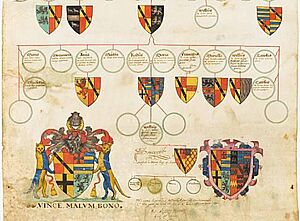Robert Glover (officer of arms) facts for kids
Robert Glover (born 1544 – died April 10, 1588) was an important English expert during the time of Queen Elizabeth I. He worked as an officer of arms, which means he was in charge of heraldry (coats of arms) and genealogy (family histories). He was also an antiquarian, someone who studies old things.
At the College of Arms, he became a Somerset Herald of Arms in 1571. He held this job until he passed away in 1588. He also worked closely with his father-in-law, William Flower, who was the Norroy King of Arms. Together, they traveled across northern England to record family histories and coats of arms.
Contents
Life and Work of Robert Glover
Robert Glover was the son of Thomas Glover, who lived in Ashford, Kent. In 1567, when Robert was 24, he got his first job at the College of Arms. He became a Portcullis Pursuivant of Arms.
Glover's Reputation and Family
Other experts in heraldry respected Glover a lot. They thought he was very accurate and knew a great deal about his work. Top officials saw him as a leading authority.
Around 1570, Robert Glover married Elizabeth Flower. She was the daughter of William Flower, the Norroy King of Arms. Robert and Elizabeth had five children: Thomas, John, Robert, Ann, and Mildred.
Glover's Career Progression
Glover worked as his father-in-law's assistant until his death. In 1571, Glover was promoted to Somerset Herald of Arms. On March 9, 1580, Queen Elizabeth gave a special permission. This allowed Glover to share the job of Norroy King of Arms with his father-in-law, William Flower. The queen noted that Flower was 82 years old at the time.
Travels and Royal Duties
In 1582, Glover traveled to Denmark with Lord Willoughby. Their mission was to give the Order of the Garter award to King Frederick II. Two years later, in 1584, he went with Robert Cooke, another herald. They joined the Earl of Derby to present the Garter award to Henry III of France.
Robert Glover died on April 10, 1588, when he was 46 years old. He was buried in London at St Giles-without-Cripplegate.
Heraldic Visitations Explained
In 1530, King Henry VIII gave instructions for "heraldic visitations." These were official tours made by heralds. The Clarenceux and Norroy Kings of Arms, or their assistants, would travel. They would visit different areas to record coats of arms and family trees. They could even stop people from using coats of arms they weren't allowed to have.
Flower's Visitations with Glover
William Flower's visitations started in 1563–1564. His last one was in 1575. Robert Glover worked as his assistant during these trips. Records from Flower's visitations are kept at the College of Arms in London. These include visits to Yorkshire (1563–1564), Lancashire (1567), Nottingham (1569), and Durham (1575). A special record from the 1567 visitation, written by Glover himself, is often called Glover's Visitation. It has 104 pages and shows the family trees of 112 families, each with their coats of arms.
Glover's Own Visitations
Robert Glover also led his own visitations. He visited Cheshire in 1580 for Flower. He also went to Staffordshire in 1583 and Yorkshire in 1584–1585.
Glover's Work in Genealogy
Robert Glover was also an early genealogist and an antiquarian. This means he studied family histories and old things.
Innovations in Record Keeping
Before Glover, heralds mainly wrote down family stories and drew coats of arms. Glover changed this by adding copies of old documents, like charters, to the visitation records. This helped prove family claims and made the records more accurate.
Glover's Manuscripts and Publications
When Glover died, he left many handwritten documents. His family trees were used by another famous antiquarian, William Camden, for his book Britannia (1594).
Glover's nephew, Thomas Milles, helped publish some of his work. One book was Nobilitas Politica et Civilis (London, 1608). Milles also translated and edited Glover's Latin family histories of noble families. This book was called The Catalogue of Honor, or Treasury of true Nobility (London, 1610). Some of Glover's other writings, like A Catalogue of Northern Gentry whose surnames ended in son, were never published. His Ordinary of Arms was printed in a later book about heraldry in 1780.
Arms
 |
|


